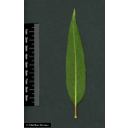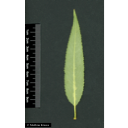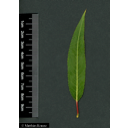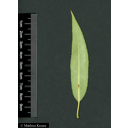Useful information about the taxon (species, subspecies, variety...)
Salix × fragilis L. 1753
Salicaceae
(APG IV)crack willow
Taxon concept: The Plant List (2014), version 1.1
Distribution: Turkey; introduced in Europe; Caucasus, Iran, West Siberia; United States, western South America, Australia
Flowering period: IV - V
Salix × fragilis L. - Accepted: Salix × fragilis L. bei The Plant List (2010); Familie: Salicaceae (APG III)Salix × fragilis L. - Accepted: Salix × fragilis L. bei The Plant List (2014), version 1.1; Familie: Salicaceae (APG III)Salix fragilis L. - Accepted: Salix fragilis L. bei Zander 2008; Familie: Salicaceae (Zander 2008)Salix fragilis L. - Synonym: Salix × fragilis L. bei The Plant List (2014), version 1.1; Familie: Salicaceae (APG III)Salix fragilis L. - Accepted: Salix fragilis L. bei Schmeil-Fitschen 2019; Familie: Salicaceae (APG IV)Salix fragilis L. - Accepted: Salix fragilis L. bei BfN Checklist Flora DE; Familie: Salicaceae (APG IV)Salix × fragilis L. - Accepted: Salix × fragilis L. bei World Flora Online - APG IV (Angiosperms); Familie: Salicaceae (World Flora Online - APG IV (Angiosperms))
- Color of flower
- yellow (male flowers) or green (female flowers)
- Flowers
- dioecious; flowers in catkins
- Flower ecology
- insect-pollinated (entomophilous) (bees)
- Life form
- woody, tree
- Foliage persistence
- deciduous
- Fruits
- capsule fruit; seeds with wooly white tuft
- Fruit ecology
- wind-dispersed (anemochorous) (seed dispersal) or water-dispersed (hydrochorous) (vegetative dispersal)
- Soil conditions
- on perculating wet, temporarily flooded, nutrient-rich and alkaline, mostly limestone-poor gravel, sand or loam soils, immature alluvial soils
- Light conditions
- semi-shade to full sun plant
- Root type
- intensive root system
- Succession type
- pioneer species, soil stabiliser
- Natural occurrence (habitat)
- willow scrubs, along small streams and stream banks, river valleys, at lakes, alder galleries, ditches, riparian zones, softwood floodplains; from lowland to middle highland, rather montane and in the North
- Vegetation typ and synecology (plant community)
- character species of the Salicetum fragilis, but also in other Salicetum communities or in the Stellario-Alnetum (Alno-Ulmion)
- Constraints according soil conditions
- not salt tolerant
- Constraints according habitat
- tolerant to strong winds
- Usage
- stems are used for basket making; wood is used for floors, cart bases, for charcoal and as fuelwood; bark can be used as tanning agent and for medicinal purposes
Erhardt, W., Götz, E., Bödeker, N. & Seybold, S. (2008): Der große Zander. Enzyklopädie der Pflanzennamen. Band 2. Arten und Sorten. Eugen Ulmer KG, Stuttgart (Hohenheim), 18. Aufl., 2103 S.; Haider, M. et al. (2005): Wildbienenkataster. See: https://www.wildbienen-kataster.de; Ministerium für Ernährung, Landwirtschaft, Umwelt und Forsten, Baden-Württemberg (Hrsg.) (1985): Pflanzenkatalog zur Verbesserung der Bienenweide und des Artenreichtums (Kurztitel: Bienenweidekatalog); Pritsch, Günter et al. (1985): Bienenweide.. Neumann-Neudamm, Melsungen; Pritsch, Günter et al. (2007): 200 Trachtpflanzen erkennen und bewerten.. Kosmos, Stuttgart; Schick, B. & Spürgin, A. (1997): Die Bienenweide. Eugen Ulmer Verlag, Stuttgart, Auflage: 4., völlig neubearb. u. erw. A., 216 S. 978-3800174188.; The International Plant Names Index (2009). Published on the Internet http://www.ipni.org; Courtesy to IPNI, 2009. Exported from IPNI at date: 2009-09-22 20:17:51; The IUCN Red List of Threatened Species. www.iucnredlist.org; Werle, Susanne et al. (2015): ITS2 DNA metabarcoding of wild bee pollen loads, collected in 2020 and 2021 across all three exploratories. See: https://www.bexis.uni-jena.de/ddm/data/Showdata/31545?version=6; Westrich, P. et al. (2018): Die Wildbienen Deutschlands.. Ulmer Verlag ISBN 978-8186-0123-2.;
Diese Webseite verwendet Google Maps, um Karten und Standorte von Pflanzen in den Hohenheimer Gärten anzuzeigen. Dadurch werden unter Umständen Daten an Google weitergeleitet, was mit einer Verarbeitung Ihrer personenbezogenen Daten verbunden sein kann. Die Datenschutzerklärung von Google finden Sie hier: Datenschutzerklärung von Google
| Sex | Standort | Accession number | Planting year | Donation | IPEN | Lat. | Long. |
|---|---|---|---|---|---|---|---|
| Parzelle X | LG-X-306-25459 | 2024 | + | XX-0-HOH-LG-X-306-25459 | 48,705061 | 9,213587 |




